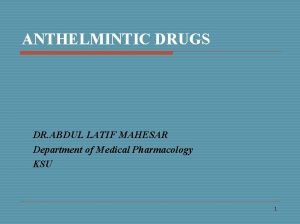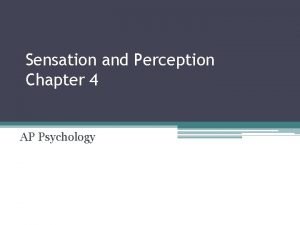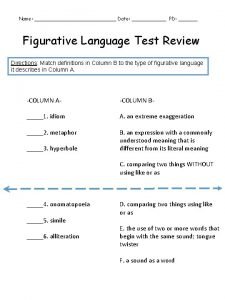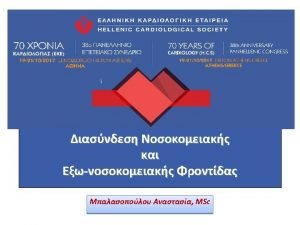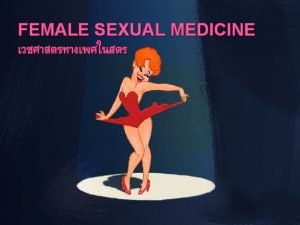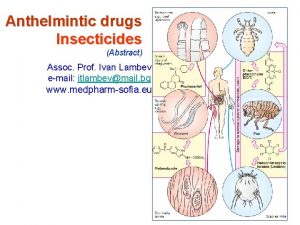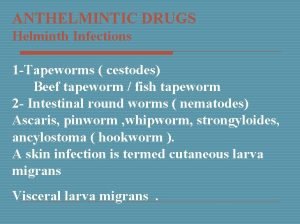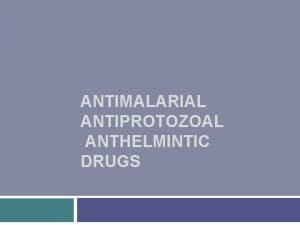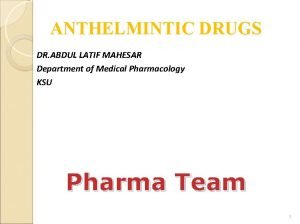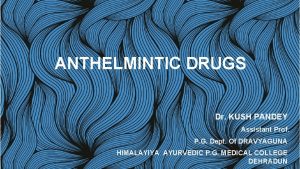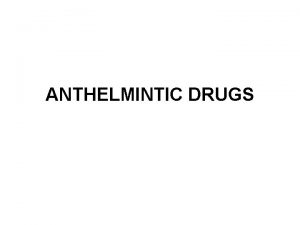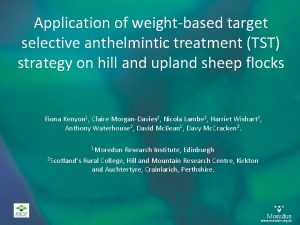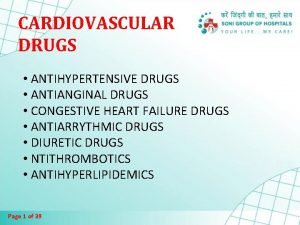ANTHELMINTIC DRUGS The doctor really just read the



















- Slides: 19

ANTHELMINTIC DRUGS The doctor really just read the slides during the lecture. . I have nth to add except things that would ease the memorization for u

ANTHELMINTIC DRUGS Albendazole broad spectrum. drug of choice for hydatid disease & cystecercosis. also used for (intestinal nematodes) pinworm, hookworm Mechanism of action: inhibits microtubule synthesis in nematodes that irreversibly impairs glucose uptake, intestinal parasites are immobilized and die slowly. orally , absorbed erratically, increased with fatty meal metabolized in the liver to active metabolite albendazole sulphoxide , half life of 8 -12 hours 11 Just for ur Infromation Recall Helminths are parasitic worms hydatid disease is a parasitic disease o f tapeworms of the. Echinococcus ty pe. Cysticercosis is a parasitic tissue infection caused by larval cysts of the tapeworm Taenia solium.

used on empty stomach for intraluminal parasites but with fatty meal when against tissue parasites. 2. Hydated diseases: drug of choice , 400 mg twice with meals for 1 month 3. Neurocysticercosis: used along with cotricosteroid to decrease the inflammation caused by dying organism Adverse effects: short term: use no significant adverse effects. long term use : abdominal distress, headache , fever , fatigue, alopecia , increased liver enzymes , pancytopenia. (low level of all blood cells produced by the bone marrow ). Not given during pregnancy & in hypersensitive people. 3

ANTHELMINTIC DRUGS ü Mebendazole ü Pyrantel Pamoate ü Piperazine ü Niclosamide ü Diethylcarbamazine Citrate ü Doxycycline ü Ivermectin ü Bithionol ü Praziquantel ü Metrifonate ü Oxamniquine

ANTHELMINTIC DRUGS Helminths that work upon Mebendazole hook worm, pin worm , ascariasis and trichuriasis Pyrantel Pamoate highly effective for pinworm, ascaris & Trichostrongylus orientalis infections and moderately effective against hookworm Piperazine Ascariasis only Niclosamide tapeworm infections (adult worm but not ova) Diethylcarbamazine Citrate for filariasis, Loa loa & tropical eosinophillia Doxycycline Wuchereria bancrofti Ivermectin onchocerciasis (river blindness) and for strongyloidiasis (flaccid paralysis ) Bithionol sheep liver fluke (Fasciola hepatica) and lung fluke (Paragonimus westermani Praziquantel schistosome infections of all species & most other trematode & cestode infections, including cysticercosis Metrifonate Schistosoma haematobium infections. Not active against S mansoni or S japonicum Oxamniquine S mansoni infections. Not effective against S haematobium or S japonicum Check this out AFTER finishing the rest of slides

Mebendazole has wider spectrum and is more safe than albendazole Mechanism of action: inhibits microtubule synthesis, irreversibly impairs glucose uptake. Intestinal parasites are immobilized & die slowly. kills hook worm, pin worm , ascariasis and trichuriasis. Less than 10% of drug is absorbed Absorption increases with fatty meal. converted to inactive metabolites rapidly in liver. half life of 2 -6 hours Given orally before or after meals, tablets should be chewed before swallowing. Adverse effects and precautions: short term therapy. Mild GI disturbance. high dose Hypersensitivity reactions, agranulocytosis (rare) , alopecia , elevation of liver enzymes. 13 caution under 2 ys of age may cause convulsion.

Pyrantel Pamoate Broad-spectrum antihelminthic, highly effective for pinworm, ascaris & Trichostrongylus orientalis infections and moderately effective against hookworm. A neuromuscular blocker, causes paralysis of worms, which is followed by expulsion. Effective in intestinal tract, not in the tissues or the ova Given orally once with or without food. For pinworm, the dose is repeated in 2 weeks. For ascariasis, a single dose be repeated if eggs are found 2 weeks after treatment. For hookworm, a single dose is effective against light infections. In heavy infections, a 3 -day course. A course of treatment can be repeated in 2 weeks. 7

Piperazine Only recommended for the treatment of ascariasis. Causes paralysis of ascaris by blocking ACh at the myoneural junction. live worms are expelled by normal peristalsis. readily absorbed orally and excreted unchanged in urine. Given orally once daily for 2 days. For heavy infections treatment is repeated after 1 wk. Adverse effects: generally mild (5– 30%) nausea, vomiting, diarrhea, abdominal pain, dizziness, & headache. Neurotoxicity & allergic reactions are rare. 8

Niclosamide Used for the treatment of most tapeworm infections. Niclosamide is a salicylamide derivative. Minimally absorbed from the GIT. Adult worms (but not ova) are rapidly killed, due to inhibition of oxidative phosphorylation or stimulation of ATPase activity. Clinical Uses 2 g once, given in the morning on an empty stomach. The tablets must be chewed thoroughly and then swallowed with water. Purgative needed( )ﺑﺤﺘﺎﺝ ﺳ ﻝ. Adverse effects: Mild , infrequent and transitory GI disturbance 9

Diethylcarbamazine Citrate Drug of choice for filariasis, Loa loa & tropical eosinophillia. Rapidly absorbed from gut, half life of 2 -3 hours , excreted in urine unchanged. Mechanism of action: immobilizes microfilariae and alters its surface structure , making them susceptible to destruction by host defense mechanism Microfiliariae are rapidly killed. adult worms are killed slowly requiring several course of treatment The mode of action against adult worms is unknown. 10

Adverse Reactions generally mild and transient, include headache, malaise, anorexia, weakness, nausea, vomiting, and dizziness. Adverse effects also occur as a result of the release of proteins from dying microfilariae or adult worms. Reactions include fever, malaise, papular rash, headache, gastrointestinal symptoms, cough, chest pain, and muscle or joint pain. Leukocytosis is common (white blood cell count above the normal range in the blood). Eosinophilia (abnormally high amounts of eosinophils). Proteinuria may also occur. Caution when using diethylcarbamazine in patients with hypertension or renal disease. 11

Doxycycline: is an Antibiotic of tetracycline groups , Broad spectrum. . They work on Helminths , too. Has macrofilaricidal activity against Wuchereria bancrofti (lymphatic filariasis), and better activity than any other available drug against adult worms. Active also against onchocerciasis (river blindness) Doxycycline acts indirectly, by killing Wolbachia, an intracellular bacterial symbiont of filarial parasites. (so it kills a bacteria In the microfilaria that cause its death -may be this bac. Is part of its flora- ) It may be used for filariasis, both for treatment of active disease and in mass chemotherapy campaigns. 12

Ivermectin Drug of choice for the treatment of onchocerciasis (river blindness) and for strongyloidiasis. Strongyloidiasis: A GABA agonists Paralyzes nematodes, causing a flaccid paralysis in the worm. Does not cross the blood brain barrier in humans (therefore little CNS effects). -but if someone has Meningitis for example it then can cross it- Onchocerciasis: Microfilaricidal. It does not kill adult worms but blocks the release of microfilariae. After a single dose, microfilariae in the skin diminish rapidly within 2– 3 days. Microfilariae in the anterior chamber of the eye decrease slowly over months. Repeated doses have a low macrofilaricidal action and permanently reduce microfilarial production. 13

Adverse Reactions: In strongyloidiasis: fatigue, dizziness, nausea, vomiting, abdominal pain, and rashes. In onchocerciasis Occurs in 5– 30% , generally mild due to the killing of microfilariae. A more intense reaction in 1– 3% A severe reaction in 0. 1%, including high fever, hypotension, and bronchospasm. Swellings and abscesses occasionally occur at 1– 3 weeks at sites of adult worms. Corneal opacities & eye lesions may develop several days after treatment. 14

Bithionol the drug of choice in the treatment of sheep liver fluke (Fasciola hepatica) and the second drug of choice in lung fluke (Paragonimus westermani ). Mechanism of action: Unknown, bithionol may work may uncoupling oxidative phosphorylation, thus reducing the production of ATP in the helminthes. Adverse Reactions: generally mild (40% of patients) and include: diarrhea, abdominal cramps, anorexia, nausea, vomiting, dizziness, and headache. Skin rashes may occur, a reaction to antigens released from dying worms. 15

The doctor told us a story about Bithionol Discovery : there was a zoo keeper who owned two Bengal tigers that died because of Paragonimus westermani fluke *before discovering them *. . He wanted to know what killed his tigers He took a biopsy from them , examine them & discover this fluke. . So it was named after him. . westermani

Praziquantel Effective in schistosome infections of all species & most other trematode & cestode infections, including cysticercosis. safe and effective as a single oral dose. Useful in mass treatment of several infections. Plasma concentrations of praziquantel increase when the drug is taken with a high-carbohydrate meal. It increases the permeability of cell membranes to calcium, resulting in paralysis, dislodgement, and death. Mild and transient adverse effects, except for Neurocysticercosis due to inflammatory reactions around dying parasites. 17

Metrifonate Safe, low-cost alternative drug for Schistosoma haematobium infections. Not active against S mansoni or S japonicum. Organophosphate cholinesterase inhibitor temporarily paralyzes the adult worms, resulting in their shift from the bladder venous plexus to small arterioles of the lungs, where they are trapped, encased by the immune system, and die. Given three times orally at 14 -day intervals. A prophylactic agent when given monthly to children Used in mass treatment programs. 18

Oxamniquine Alternative to praziquantel for the treatment of S mansoni infections. Used extensively for mass treatment. Not effective against S haematobium or S japonicum. Active against both mature and immature stages. The mechanism of action is unknown. Contraction and paralysis of the worms results in detachment from terminal venules in the mesentery and transit to the liver, where many die. Surviving females return to the mesenteric vessels but cease to lay eggs. In mixed schistosome infections, it has been used in combination with metrifonate. 19
 Anthelmintic drugs
Anthelmintic drugs Doctor who google drive
Doctor who google drive Did paris love juliet?
Did paris love juliet? The animal i really dig
The animal i really dig Subliminal messages
Subliminal messages This is really scary with long
This is really scary with long Heavenly father prayer
Heavenly father prayer Tell me what you really like
Tell me what you really like Tell me whats really going on
Tell me whats really going on Meme icebreaker
Meme icebreaker Really bad powerpoint presentations
Really bad powerpoint presentations If the book have been cataloged
If the book have been cataloged Cups on a string
Cups on a string Seven steps to the scientific method
Seven steps to the scientific method The fly buzzed past us
The fly buzzed past us We must stop these silly pretences
We must stop these silly pretences It's really fascinating
It's really fascinating Past tense for wish
Past tense for wish Proofs that really count
Proofs that really count Anyway the thing is what i really mean
Anyway the thing is what i really mean
